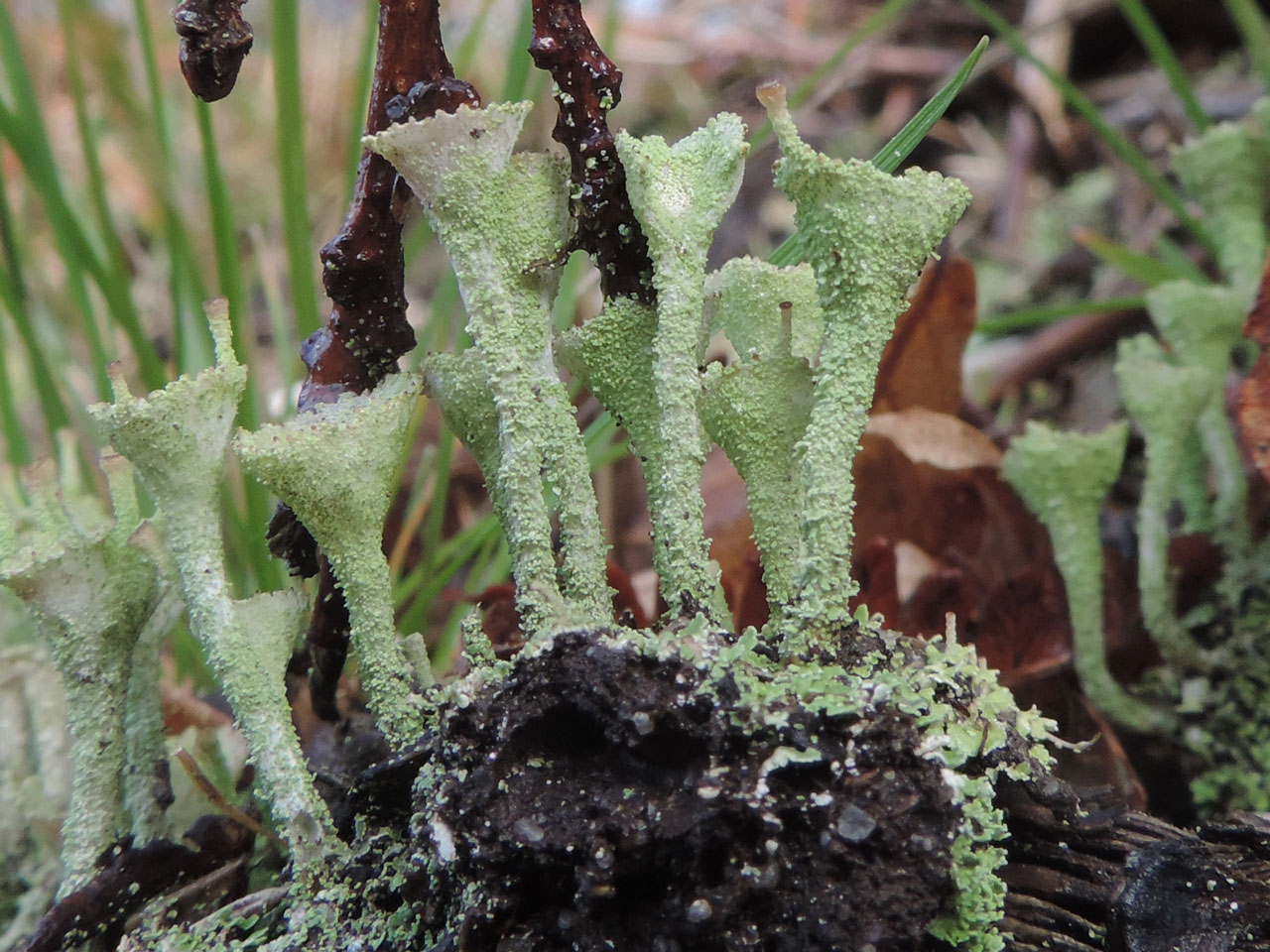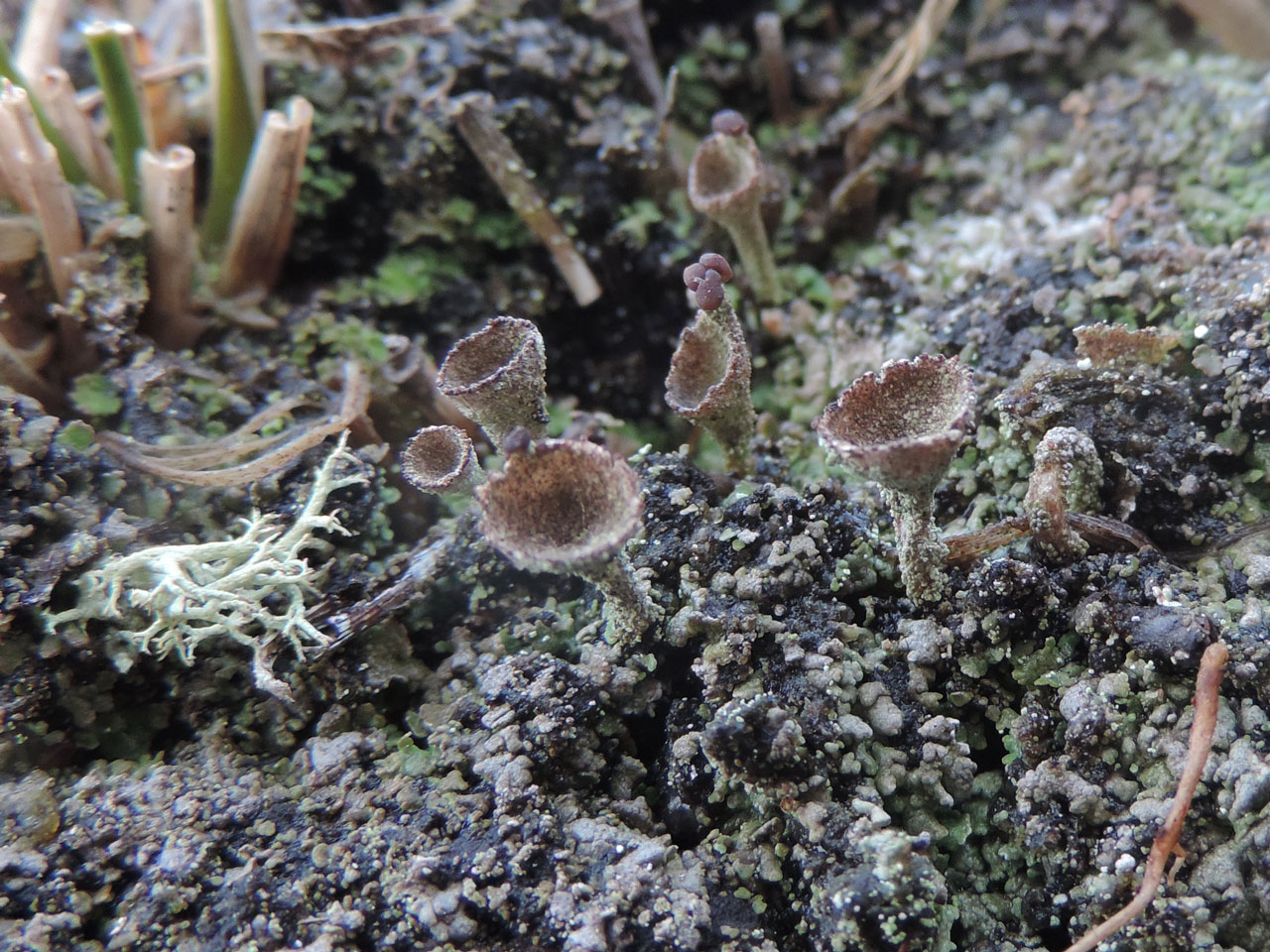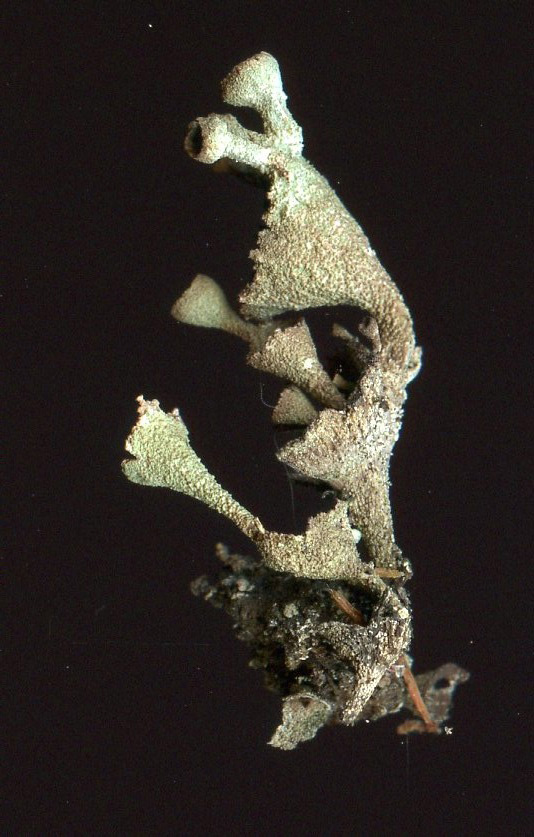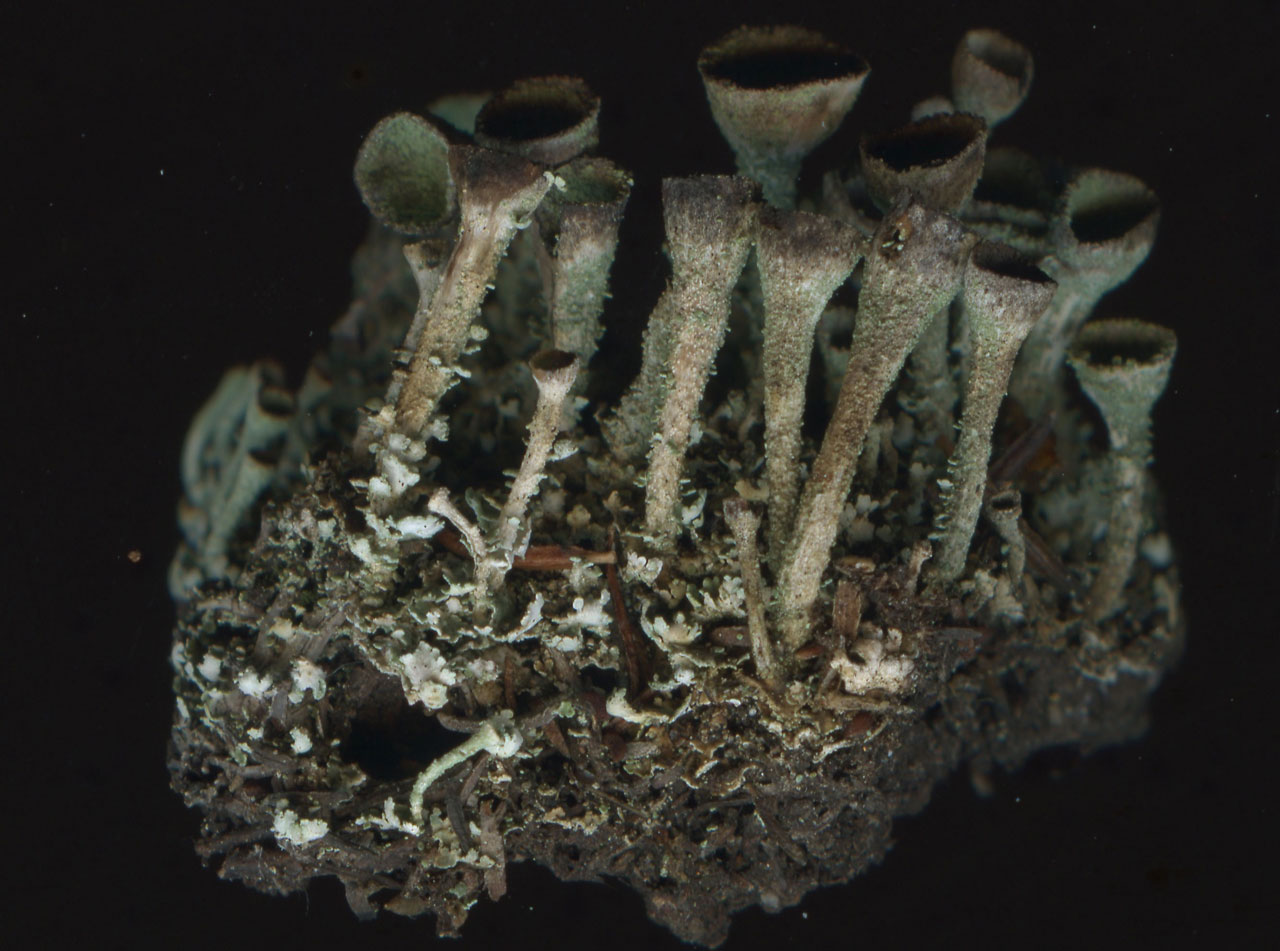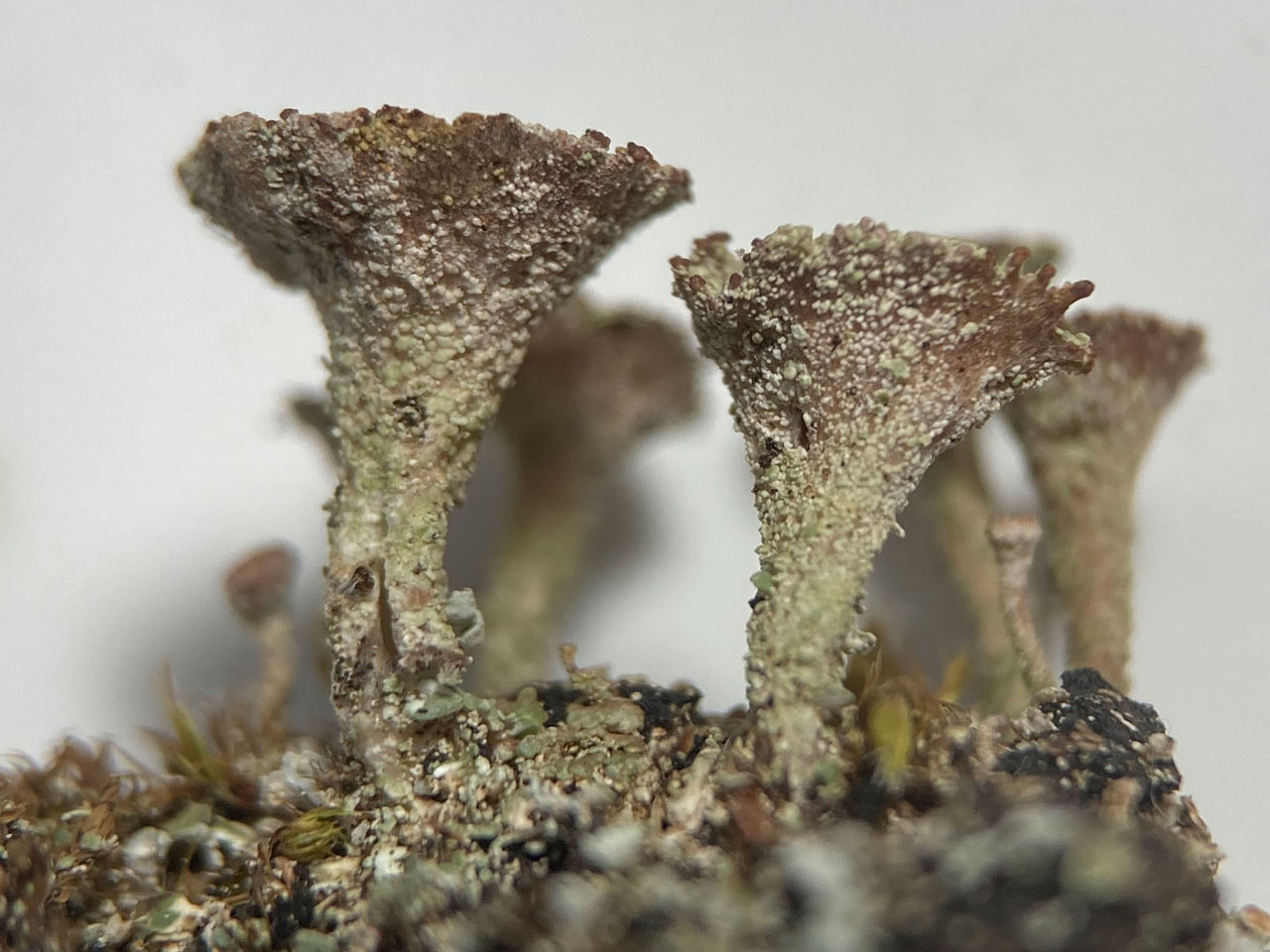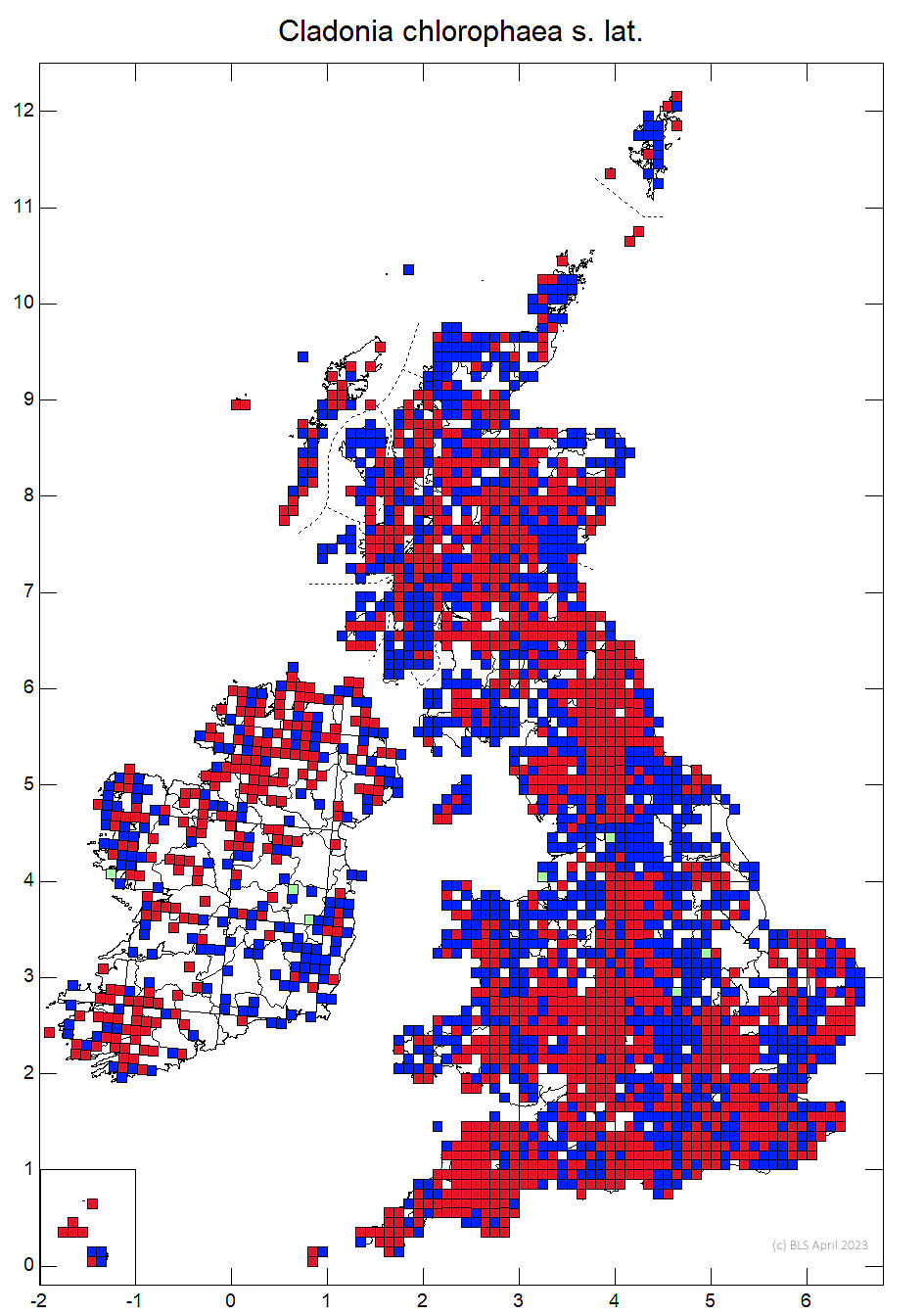Cladonia chlorophaea s. lat.
Cladonia chlorophaea
Cladonia cryptochlorophaea
Cladonia grayi
Cladonia merochlorophaea
Cladonia novochlorophaea
This map only shows records entered to the database as s. lat., there are separate maps for records assigned to the component taxa.
The Cladonia chlorophaea s. lat. morphocomplex includes Pixie Cups with brown apothecia and course soredia or granules, excluding C. fimbriata with fine soredia or C. pyxidata with corticate granules, present even in juvenile material and lacking any granular soredia. Included within Cladonia chlorophaea s. lat. are two only distantly related groups C. chlorophaea s. str. in one and Cladonia grayi and its relatives (Cladonia asahinae, Cladonia cryptochlorophaea, Cladonia merochlorophaea and Cladonia novochlorophaea) in the other. Cladonia chlorophaea podetia are usually greenish with any exposed medulla being white and it lacks K+ or C+ spot tests or UV fluorescence. In contrast C. grayi s. lat. taxa are typically browner and have pink-brown tinged exposed medulla, and can have K+ or C+ spot tests or UV fluorescence, but TLC is required for definitive separation.
Cladonia grayi and its relatives (Cladonia asahinae, Cladonia cryptochlorophaea, Cladonia merochlorophaea and Cladonia novochlorophaea) have previously been included in a morphological assembly with C. chlorophaea (e.g. James 2009), and the complex (as C. chlorophaea s.lat. BLS 0371) is accepted as a pragmatic recording unit by some lichenologists. However, molecular data are incomplete, but C. chlorophaea occupies a different phylogenetic branch to the C. grayi aggregate, and is close to C. fimbriata within the Cladonia subclade Graciles (Stenroos et al. 2019).
Cladonia chlorophaea podetia are usually greenish with any exposed medulla being white and it lacks K+ or C+ spot tests or UV fluorescence. In contrast C. grayi s. lat. taxa are typically browner and have pink-brown tinged exposed medulla, and can have K+ or C+ spot tests or UV fluorescence, but TLC is required for definitive separation. Microcrystal tests (Orange 1992, Orange et al. 2010) are also powerful tools for identification in this group.
Cladonia chlorophaea and C. grayi s. lat. are also frequently confused with C. fimbriata, which has more abruptly tapering, goblet-shaped scyphi and is entirely farinose-sorediate. Also similar is C. pyxidata which has gradually tapered scyphi almost to the base and covered with distinctly coarse, corticate granules, present even in juvenile material and lacking any granular soredia.
Summary of the chemistry of the Cladonia chlorophaea morphological complex. Populations outside of Britain and Ireland may show different chemotypes. Data taken from James (2009) and Ahti & Stenroos (2013).
| Species | C | K | KC | PD | UV | Chemistry |
| asahinae | – | – | – | R | – | Fumarprotocetraric, rangiformic, norrangiformic acids |
| chlorophaea | – | – | – | R | – | Fumarprotocetraric |
| cryptochlorophaea | ±Y | R/B | WR | OR | (Pale Yellow) | Cryptochlorophaeic, fumarprotocetraric, paludosic acids |
| grayi | – | – | – | ±R | Mauve | Grayanic, ± fumarprotocetraric acids |
| merochlorophaea | ±R | – | WR | ±OR | (Blue) | Merochlorophaeic, 4-O- methylcryptochlorophaeic, ± fumarprotocetraric acids |
| novochlorophaea | Y | – | – | ±OR | ±White | Sekikaic, homosekikaic, ± fumarprotocetraric acids |
Key R = Red, Y = Yellow, R/B = red to brownish, OR = Orange-red, W = Wine-red & () = Week UV fluorescence.
Ahti & Stenroos (2013) observe that C. chlorophaea tends to occupy somewhat less acidic habitats than C. grayi s. lat. These include less acid bark and lignum, decaying worked timber, acid grassland and loamy banks; it is largely replaced by C. grayi s. lat. in heathland and moorland and on acid bark and lignum

Ahti, T. & Stenroos, S. (2013). Cladoniaceae. In: Ahti, T., Stenroos, S., & Moberg, R. (eds), Nordic Lichen Flora 5: 1–117.
James, P.W. (2009). Cladonia. In: Lichens of Great Britain and Ireland (Smith, C.W., Aptroot, A., Coppins, B.J., Fletcher, A., Gilbert, O.L., James, P.W. & Wolselsey, P.A. eds): 309–338. London: British Lichen Society.
Orange, A. (1992). A key to the Cladonia chlorophaea group in Europe, using microcrystal tests. Bulletin of the British Lichen Society 70: 36–42.
Orange, A., James, P.W. & White, F.J. (2010). Microchemical Methods for the Identification of Lichens. 101 pp. London: British Lichen Society.
Pino-Bodas, R., Sanderson, N., Cannon, P., Aptroot, A., Coppins, B., Orange, A. & Simkin, J. (2021). Lecanorales: Cladoniaceae, including the genera Cladonia, Pilophorus and Pycnothelia. Revisions of British and Irish Lichens 19: 1-45. Link
Stenroos, S., Pino-Bodas, R., Hyvonen, J., Lumbsch, H.T. & Ahti, T. (2019). Phylogeny of the family Cladoniaceae (Lecanoromycetes, Ascomycota) based on sequences of multiple loci. Cladistics 35: 351–389
Text by N A Sanderson, based Pino-Bodas et al (2021)
